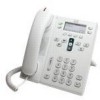Cisco 6941 Administration Guide - Page 155
Where to Go for More Troubleshooting Information, Cleaning the Cisco Unified IP Phone
 |
UPC - 882658277801
View all Cisco 6941 manuals
Add to My Manuals
Save this manual to your list of manuals |
Page 155 highlights
Chapter Where to Go for More Troubleshooting Information • G.728/iLBC: 3.9 MOS LQK • G729A/AB: 3.7 MOS LQK Note • Cisco Voice Transmission Quality (CVTQ) does not support wideband (7 kHz) speech codecs, because ITU has not defined the extension of the technique to wideband. Therefore, MOS LQK scores that correspond to G.711 performance are reported for G.722 calls to allow basic quality monitoring, rather than not reporting an MOS score. • Reporting G.711-scale MOS scores for wideband calls through the use of CVTQ allows basic-quality classifications to be indicated as good/normal or bad/abnormal. Calls with high scores (approximately 4.5) indicate high quality or a low packet loss, and lower scores (approximately 3.5) indicate low quality or a high packet loss. • Unlike MOS, the conceal ratio and concealed seconds metrics remain valid and useful for both wideband and narrowband calls. A conceal ratio of zero indicates that the IP network is delivering frames and packets on time with no loss. Where to Go for More Troubleshooting Information If you have additional questions about troubleshooting the Cisco Unified IP Phones, several Cisco.com web sites can provide you with more tips. Choose from the sites available for your access level. • Cisco Unified IP Phone Troubleshooting Resources: http://www.cisco.com/en/US/products/hw/phones/ps379/tsd_products_support_troubleshoot_and_ alerts.html • Cisco Products and Services (Technical Support and Documentation): http://www.cisco.com/en/US/products/ps10326/tsd_products_support_series_home.html Cleaning the Cisco Unified IP Phone To clean your Cisco Unified IP phone, use only a dry soft cloth to gently wipe the phone and the LCD screen. Do not apply liquids or powders directly on the phone. As with all non-weather-proof electronics, liquids and powders can damage the components and cause failures. Cisco Unified IP Phone 6921, 6941, 6945, and 6961 Administration Guide for Cisco Unified Communications Manager 8.5 (SCCP and SIP) OL-23769-01 9-15















